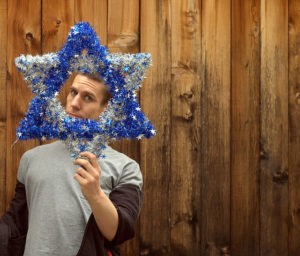 Does the thought of High Holy Day services make you want to scurry into bed and pull the covers over your nose? We don’t want to admit it—at least I don’t—but even rabbis will sometimes acknowledge services can be boring.
Does the thought of High Holy Day services make you want to scurry into bed and pull the covers over your nose? We don’t want to admit it—at least I don’t—but even rabbis will sometimes acknowledge services can be boring.
I say this as a woman who was once married to a cantor and whose son wants to be one too, which means I’ve been to a lot of services. So when a friend who recently moved to D.C. wrote me about a Kol Nidrei service at a Conservative synagogue called Adas Israel that was “amazing,” I had my doubts.
What was so amazing, I asked? His answer came in five paragraphs, and by the end I wanted nothing more than to see his synagogue. He started by saying the service was outside, under the stars (which may be easier in D. C. than Minnesota).
Adas Israel had engaged Israeli folk singers and musicians who played, chanted and sang the liturgy, using instruments from ancient times. The service was set up as a sing-along so the congregation could participate in almost everything. My friend described it as a Jewish version of singing along with Handl’s Messiah.
The Israeli and Sephardic melodies brought new energy to the prayers, engaging my friend much more than the classic Ashkenazy melodies he’d grown up singing. At one point, a famous cellist performed what my friend called a “phenomenally moving rendition” of the Kol Nidrei, which was then chanted and sung by everyone, along with the cantor and folk choir.
Reading this, I thought even if a synagogue was Orthodox and didn’t want to use instruments, the chants and communal singing outdoors would be exceptional. And I wanted to see more of this shul.
“Being under the stars with a big moon lighting our prayer books was an extraordinary experience by itself,” my friend added.
I’m telling you this because although the service really intrigued me, the Washington Post and every other paper I read were much more interested in the synagogue rabbi’s personal life than the experience he offers congregants.
Why was the media interested? Because the rabbi had recently come out as a gay man. You can read more about the story here, but I will just leave you with the Washpo title:
In a D. C. rabbi’s e-mail, revelation and relief: ‘I am a gay man’
But is that really the story? I support the rabbi’s choice and I feel for him and his wife. I think they must both be extraordinary people.
But why isn’t anyone reporting on the service this rabbi created?
Why is it that one of the most interesting services in the country isn’t noticed by reporters, and in fact is sloughed off in favor of a private matter that isn’t anyone’s business? Could it be that the rabbi’s choices have something to do with sex and that’s what sells papers?
Huffpo, Washpo, Forward, Daily Mail et al, I have news for you. It’s 2014 and there are a lot of stories out there about people coming out (rabbis, Christians, and others just like the rest of us). But if there are stories about High Holy Day services that make us sit up and take notice, I’m not seeing them. Thanks to you.
My friend continued his description of the service and I tried to imagine the scene he created:
No sermon. No requests for donations. No administrative announcements. Just the liturgy as roadmap, HaShem’s sky, the officiants and the congregation seeking repentance and atonement together. A community of Jews communing together.
There was a spirituality present that I had not sensed before, brought about by the milieu. As we prayed and sang, pedestrians gathered on the streets surrounding the shul’s plaza and watched and listened to the service.”
My friend concluded by saying it was a glorious way to begin the new year.
While the Post shared the rabbi’s e-mail to the congregation with his decision to come out, I learned nothing about the experiences people were enjoying at his synagogue. Would they describe Nobel winner Malala Yousafzai by talking about her love life?
In less than a week, the High Holy Day season will come to a close, and readers will likely forget about this story. But I have a feeling the people who attended services at Adas will not forget what they saw and heard there.
What I’m praying for, this New Year, is that the time comes (speedily, yes, and soon) when we open the paper and read about what rabbis are doing in their congregations instead of their beds. And follow their examples—gay or straight—to find new energy and meaning in the most ancient ceremonial practices.
Jewish man photo: David Goehring

